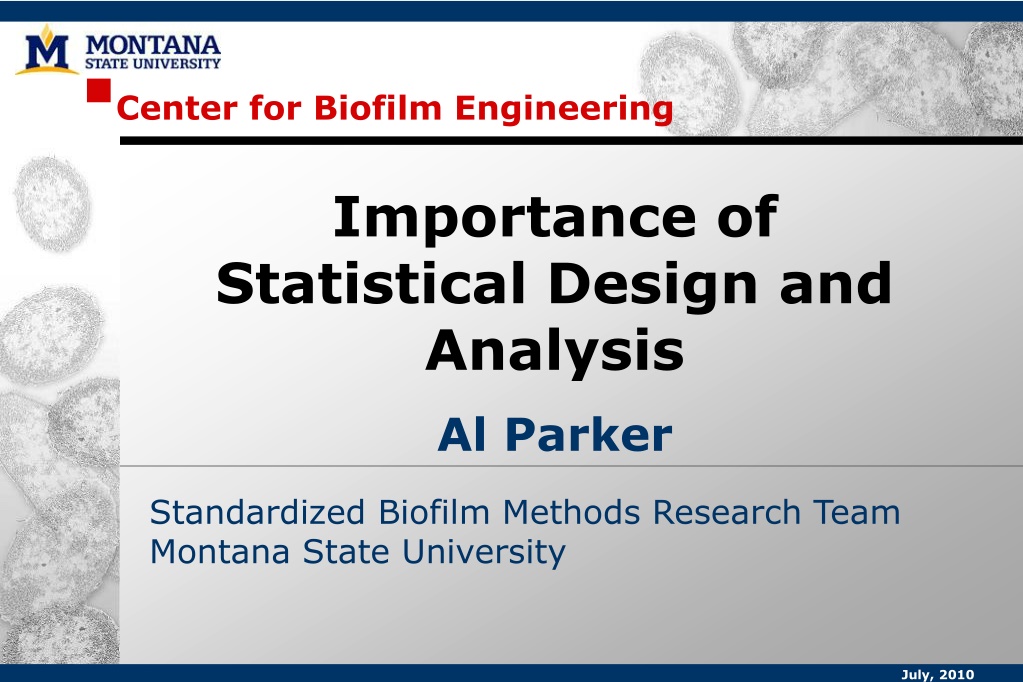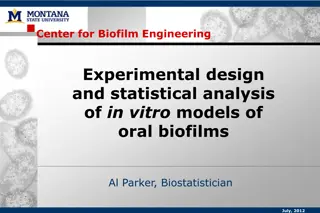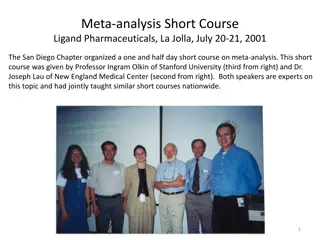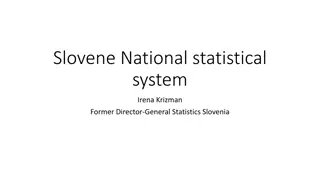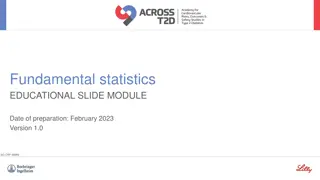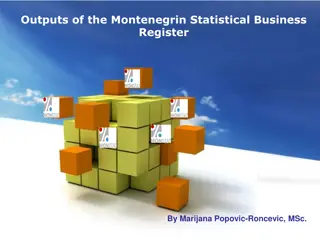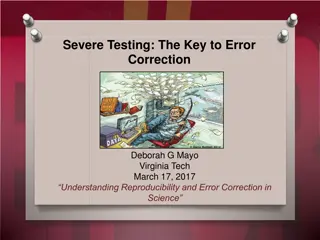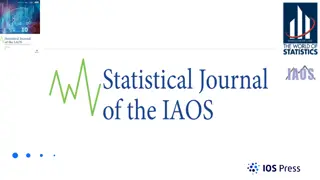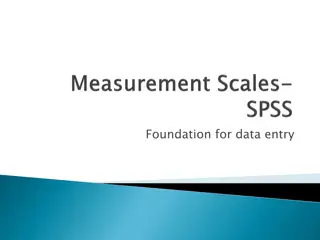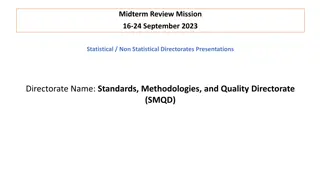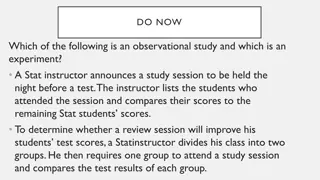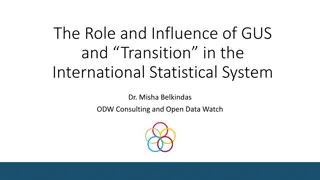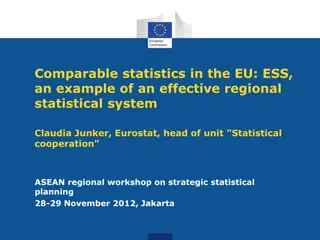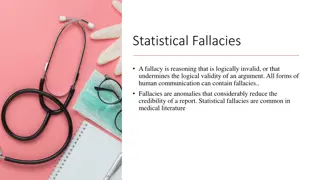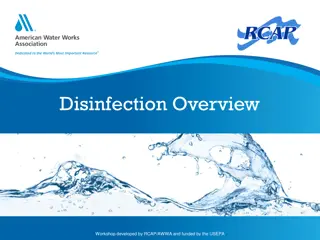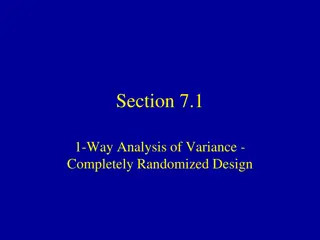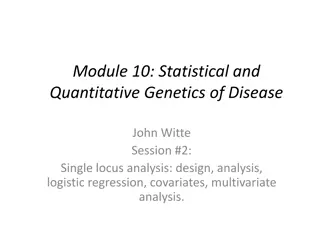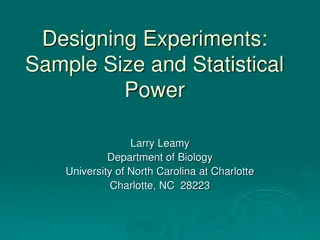Importance of Statistical Design and Analysis in Biofilm Research
The importance of statistical thinking in biofilm research is highlighted through standardized methods, statistical tool applications like ANOVA, and attributes of a standard method such as Relevance, Reasonableness, and Reproducibility. Statistical design aids in generating convincing results, anticipating criticism, improving efficiency, and enhancing communication in laboratory settings. The concept of resemblance, as demonstrated by the repeatability of control data, underscores the reliability and reproducibility of experimental outcomes in biofilm studies.
Download Presentation

Please find below an Image/Link to download the presentation.
The content on the website is provided AS IS for your information and personal use only. It may not be sold, licensed, or shared on other websites without obtaining consent from the author. Download presentation by click this link. If you encounter any issues during the download, it is possible that the publisher has removed the file from their server.
E N D
Presentation Transcript
Center for Biofilm Engineering Importance of Statistical Design and Analysis Al Parker Standardized Biofilm Methods Research Team Montana State University July, 2010
Standardized Biofilm Methods Laboratory Al Parker Lindsey Lorenz Marty Hamilton Darla Goeres Paul Sturman Diane Walker Kelli Buckingham- Meyer
What is statistical thinking? Data Design Uncertainty assessment
What is statistical thinking? Data (pixel intensity in an image? log(cfu) from viable plate counts?) Design - controls - randomization - replication (How many coupons? experiments? technicians? Labs?) Uncertainty and variability assessment
Why statistical thinking? Provide convincing results Anticipate criticism Increase efficiency Improve communication
Attributes of a standard method: Seven Rs Relevance Reasonableness Resemblance Repeatability (intra-laboratory reproducibility) Ruggedness Responsiveness Reproducibility (inter-laboratory)
Attributes of a standard method: Seven Rs Relevance Reasonableness Resemblance Repeatability (intra-laboratory reproducibility) Ruggedness Responsiveness Reproducibility (inter-laboratory)
Resemblance Independent repeats of the same experiment in the same laboratory produce nearly the same control data, as indicated by a small repeatability standard deviation. Statistical tool: nested analysis of variance (ANOVA)
Resemblance Example Data: log10(cfu) from viable plate counts Coupon Density LD cfu / cm2 log(cfu/cm2) 1 5.5 x 106 6.74 2 6.6 x 106 6.82 3 8.7 x 106 6.94 Mean LD= 6.83
Resemblance Example control LD 6.73849 6.82056 6.93816 Mean LD Exp 1 1 1 SD 6.83240 0.10036 2 2 2 6.66276 6.73957 6.74086 6.71440 0.04473 3 3 3 6.91564 6.74557 6.89758 6.85293 0.09341
Resemblance from experiment to experiment 6.95 Mean LD = 6.77 6.90 6.85 log10 (cfu/cm2) Sr = 0.15 6.80 log(cfu) 6.75 the typical distance between a control coupon LD from an experiment and the true mean LD 6.70 6.65 6.60 6.55 1 2 3 experiment
Resemblance from experiment to experiment 6.95 The variance Sr2 can be partitioned: 6.90 6.85 log10 (cfu/cm2) 69% due to between experiment sources 6.80 log(cfu) 6.75 6.70 6.65 31% due to within experiment sources 6.60 6.55 1 2 3 experiment
Formula for the SE of the mean control LD, averaged over experiments 2 Sc = within-experiment variance of control coupon LD SE = between-experiments variance of control coupon LD nc = number of control coupons per experiment m = number of experiments 2 2 2 S S E c + SE of mean control LD = m nc m
Formula for the SE of the mean control LD, averaged over experiments 6.95 2 Sc = 0.31 x (.15)2 = 0.006975 SE = 0.69 x (.15)2 = 0.015525 nc = 3 m = 3 6.90 6.85 2 6.80 log(cfu) 6.75 6.70 6.65 6.60 6.55 1 2 3 experiment .015525 .006975 = 0.0771 + SE of mean control LD = 3 3 3 95% CI for mean control LD = 6.77 t6 x 0.0771 = (6.58, 6.96)
Resemblance from technician to technician 8.7 Mean LD = 8.42 8.6 8.5 log10 (cfu/cm2) Sr = 0.17 log(cfu) 8.4 the typical distance between a coupon LD and the true mean LD 8.3 8.2 8.1 experiment 1 2 3 1 2 3 Tech 1 2
Resemblance from technician to technician The variance Sr2 can be partitioned: 8.7 8.6 39% due to technician sources 8.5 log10 (cfu/cm2) log(cfu) 8.4 43% due to between experiment sources 8.3 8.2 8.1 18% due to within experiment sources experiment 1 2 3 1 2 3 Tech 1 2
Repeatability Independent repeats of the same experiment in the same laboratory produce nearly the same data, as indicated by a small repeatability standard deviation. Statistical tool: nested ANOVA
Repeatability Example Data: log reduction (LR) LR = mean(control LDs) mean(disinfected LDs)
Repeatability Example control LD 6.73849 6.82056 6.93816 Mean LD Exp 1 1 1 SD 6.83240 0.10036 2 2 2 6.66276 6.73957 6.74086 6.71440 0.04473 3 3 3 6.91564 6.74557 6.89758 6.85293 0.09341
Repeatability Example log density control 6.73849 6.82056 6.93816 mean log density control Exp 1 1 1 disinfected 3.08115 3.29326 3.03196 disinfected log reduction 6.83240 3.13546 3.69695 2 2 2 6.66276 6.73957 6.74086 2.92334 3.03488 3.21146 6.71440 3.05656 3.65784 3 3 3 6.91564 6.74557 6.89758 2.73748 2.66018 2.72651 6.85293 2.70805 4.14488 Mean LR = 3.83
Repeatability Example 4.2 Mean LR = 3.83 4.1 4.0 Sr = 0.27 3.9 LR the typical distance between a LR for an experiment and the true mean LR 3.8 3.7 3.6 3.5 1 2 3 experiment
Formula for the SE of the mean LR, averaged over experiments 2 Sc = within-experiment variance of control coupon LD Sd = within-experiment variance of disinfected coupon LD SE = between-experiments variance of LR nc = number of control coupons nd = number of disinfected coupons m = number of experiments 2 2 2 2 2 S S S E d c + + SE of mean LR = m nd m nc m
Formula for the SE of the mean LR, averaged over experiments 4.2 Sc2 = 0.006975 4.1 4.0 Sd2 = 0.014045 3.9 LR 3.8 3.7 SE2 = 0.066234 3.6 3.5 1 2 3 experiment nc = 3, nd = 3, m = 3 .066234 .006975 .014045 SE of mean LR = = 0.156 + + 3 3 3 3 3 95% CI for mean LR = 3.83 t2 x 0.156 = (3.16, 4.50)
How many coupons? experiments? .066234 .006975 .014045 + + SE of mean LR = m nd m nc m no. control coupons (nc): no. disinfected coupons (nd): no. experiments (m) 1 2 3 4 6 10 100 2 2 3 3 6 6 12 12 0.277 0.196 0.160 0.138 0.113 0.088 0.028 0.271 0.264 0.191 0.187 0.156 0.152 0.135 0.132 0.110 0.108 0.086 0.084 0.027 0.026 0.261 0.184 0.151 0.130 0.106 0.082 0.026
Reproducibility Repeats of the same experiment run independently by different researchers in different laboratories produce nearly the same result as indicated by a small reproducibility standard deviation. Requires a collaborative (multi-lab) study. Statistical tool: nested ANOVA
Reproducibility Example Mean LR = 2.61 4.0 3.5 SR = 1.07 log reduction 3.0 the typical distance between a LR for an experiment at a lab and the true mean LR 2.5 2.0 1.5 experiment 1 3 4 3 4 5 lab 1 2
Reproducibility Example The variance SR2 can be partitioned: 4.0 3.5 62% due to between lab sources log reduction 3.0 2.5 2.0 38% due to between experiment sources 1.5 experiment 1 3 4 3 4 5 lab 1 2
Formula for the SE of the mean LR, averaged over labratories Sc2= within-experiment variance of control coupon LD Sd2= within-experiment variance of disinfected coupon LD SE2= between-experiments variance of LR SL2= between-lab variance of LR nc = number of control coupons nd = number of disinfected coupons m = number of experiments L = number of labs 2 2 2 2 S S S S L E d c + + + SE of mean LR = L nc m L m L nd m L
Formula for the SE of the mean LR, averaged over labratories Sc2= 0.007569 Sd2= 0.64 SE2= .2171 SL2= 0.707668 nc = 3, nd = 3, m = 3, L = 2 4.0 3.5 log reduction 3.0 2.5 2.0 1.5 experiment 1 3 4 3 4 5 lab 1 2 .707668 .2171 .007569 .64 SE of mean LR = = 0.653 + + + 3 2 2 3 3 2 3 3 2 95% CI for mean LR = 2.61 t4 x 0.653 = (0.80, 4.42)
How many coupons? experiments? labs? .707668 .2171 .007569 .64 SE of mean LR = + + + m L L nc m L nd m L no. of labs (L) no. control/dis coupons (nc and nd): 1 1 1 2 2 2 3 3 3 4 4 4 5 5 5 6 6 6 2 3 5 2 3 5 2 3 5 2 3 5 2 3 5 2 3 5 no. experiments (m) 1 1.117 1.068 1.027 0.790 0.755 0.726 0.645 0.617 0.593 0.559 0.534 0.513 0.500 0.478 0.459 0.456 0.436 0.419 2 0.989 0.961 0.939 0.699 0.680 0.664 0.571 0.555 0.542 0.494 0.481 0.469 0.442 0.430 0.420 0.404 0.392 0.383 3 0.942 0.923 0.907 0.666 0.653 0.642 0.544 0.533 0.524 0.471 0.462 0.454 0.421 0.413 0.406 0.385 0.377 0.370 4 0.918 0.903 0.891 0.649 0.639 0.630 0.530 0.522 0.515 0.459 0.452 0.446 0.411 0.404 0.399 0.375 0.369 0.364 6 0.893 0.883 0.875 0.632 0.624 0.619 0.516 0.510 0.505 0.447 0.442 0.437 0.399 0.395 0.391 0.365 0.361 0.357 10 0.873 0.867 0.862 0.617 0.613 0.609 0.504 0.500 0.497 0.436 0.433 0.431 0.390 0.388 0.385 0.356 0.354 0.352 100 0.844 0.844 0.843 0.597 0.597 0.596 0.488 0.487 0.487 0.422 0.422 0.422 0.378 0.377 0.377 0.345 0.344 0.344
Summary Even though biofilms are complicated, it is feasible to develop biofilm methods that meet the Seven R criteria. Good experiments use control data! Assess uncertainty by SEs and CIs. When designing experiments, invest effort in numbers of experiments versus more coupons in an experiment).
